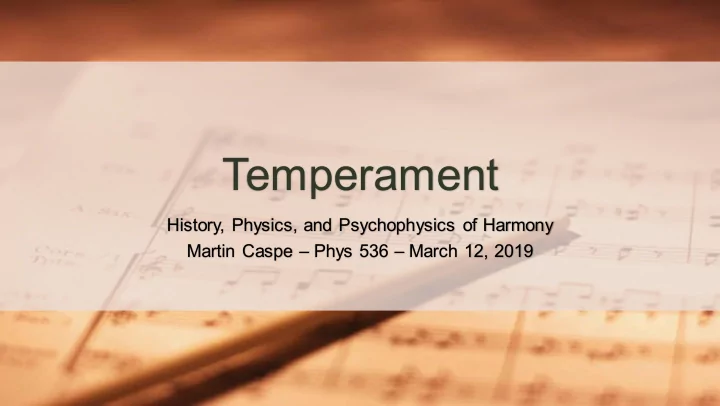

Temperament History, Physics, and Psychophysics of Harmony Martin Caspe – Phys 536 – March 12, 2019
Contents • Introduction – Who am I, and why did I choose this topic? • History of Tunings in the West • Pythagoreans – Middle Ages – Baroque Transition – Even Temperament as Standard • Physics • Characteristics of Tone – Beats and Roughness – Pure Tones versus Real Music • Psychophysics / Psychoacoustics • The Magic Octave – Other Intervals – Consonance and Dissonance – Building Scales • Conclusion
History of Tunings – Pythagoras! Pythagoras discovers: Octaves (f 2 =2 f 1 ) Circle of Fifths and Apocryphal tale of anvils Perfect fifths, (2f 2 =3 f 1 ) Pythagorean Comma Perfect fourths (3f 2 =4 f 1 ) But nobody cared for centuries! Invention and experimentation with monochord
History of Tunings – Pythagoras’ Legacy Organum – 9 th – 13 th Centuries Harpsichord – 14 th – 16 th Centuries Plainchant with harmonies, mostly Dedicated string for each key fifths and fourths Boethius – 500 CE Music of the Spheres
Physics – Comparison of Pure Tones: Pythagorian to Even Tempered Experimental Setup: • Dual output signal generator • CRATE CR-280 amplifier • Oscilloscope • Ibanez acoustic/electric guitar
Physics – Comparison of Pure Tones: Pythagorean to Even Tempered Fifths
Physics – Comparison of Pure Tones: Pythagorean to Even Tempered Fifths • Pythagorean tuning has perfect fifths (and octaves, and fourths) as expected • Beats are evident in the even tempered fifths intervals • Comparing only two notes (one interval) of pure tones it is difficult to hear the dissonance in even tuning, although it is there. ➔ Why are such subtle fluctuations such a big deal?
Physics – Pure Sines Versus Vibrating String
Physics – Pure Sines Versus Vibrating String
Psychophysics – Perception of Phenomena Psychophysics : “a branch of psychology concerned with the effect of physical processes (such as intensity of stimulation) on the mental processes of an organism” Psychoacoustics: “ a branch of science dealing with the perception of sound, the sensations produced by sounds, and the problems of communication” 2019 Merriam-Webster: https://www.merriam-webster.com/
Psychophysics – Characteristics of Tone As discussed in class: Pitch Frequency Loudness Amplitude Timbre Complexity (quality, overtones, attack decay) Add: Consonance Special frequency intervals – Octave, Fifth, Fourth Dissonance Frequencies interfere – Beats, Roughness, Wolftones Harmonies and chords are build from consonances, and avoid dissonances
Psychophysics – Consonance to Dissonance Frequency Interval Ratio 1/1 Unison 2/1 Octave “Perfect” consonances 3/2 Fifth 4/3 Fourth 5/3 Major sixth 5/4 Major third “Imperfect” consonances 6/5 Minor third 8/5 Minor sixth
Psychophysics – The Magical Octave • In real instruments, harmonic Tonic & (ascending pitch) Octave & “overtones” exist overtones overtones • Consider two strings vibrating on f 1 the interval of the fifth: f 2 = 2 f 1 2*f 1 f 2 = 2*f 1 • Each string is also producing overtone harmonics in whole- 3*f 1 number multiples of it’s dominant frequency 4*f 1 2*(2*f 1 ) = 4*f 1 • All overtones overlap – very pure, 5*f 1 ringing tone 6*f 1 3*(2*f 1 ) = 6*f 1 • All cultures have Octave concept, but may divide into 5, 17, or 22 parts, not 12
Psychophysics – Harmonic Interference • In real instruments, harmonic Tonic & (ascending pitch) Perfect fifth & “overtones” exist overtones overtones f 1 • Consider two strings vibrating on the interval of the fifth: f 2 = 3/2 f 1 f 2 = 3/2 f 1 • Each string is also producing 2*f 1 overtone harmonics in whole- 3*f 1 2*(3/2 f 1 ) = 3*f 1 number multiples of it’s dominant 4*f 1 frequency 3*(3/2 f 1 ) = 9/2*f 1 Very close – may beat • Even tuned in perfect fifths, beats may occur in the upper 5*f 1 harmonics 6*f 1 4*(3/2 f 1 ) = 6*f 1
Psychophysics – Is the Major Third Dissonant? Beat spans ~3.5 scope divisions of 4.0ms ➔ ~14ms = ~70 Hz
Conclusions • The perception of music and how intervals of notes sounds is a complex interaction between the physical phenomena and the psychophysical way we interpret them • The behaviors of pure sine wave tones gives clues to understanding how we perceive real music, but it is too simplistic • This presentation just scratched the surface of a very large field of study
Bibliography Roederer , J., “Introduction to the Physics and Psychophysics of Music”, 2 nd . Ed., Springer-Verlag, 1975 Isacoff , S., “T emperament”, Vintage Books Division of Random House, 2001 Johnston, I., “Measured T ones”, Adam Hilger impring of IOP Publishing Ltd, 1989 Hamilton, C., “Sound and its Relation to Music”, Oliver Ditson Co, 1912 Wood, A., “The Physical Basis of Music”, Cambridge University Press, Reprinted 1925
Recommend
More recommend